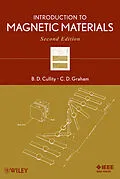Introduction to Magnetic Materials, 2nd Edition covers the basics of magnetic quantities, magnetic devices, and materials used in practice. While retaining much of the original, this revision now covers SQUID and alternating gradient magnetometers, magnetic force microscope, Kerr effect, amorphous alloys, rare-earth magnets, SI Units alongside cgs units, and other up-to-date topics. In addition, the authors have added an entirely new chapter on information materials. The text presents materials at the practical rather than theoretical level, allowing for a physical, quantitative, measurement-based understanding of magnetism among readers, be they professional engineers or graduate-level students.
Autorentext
The Late B. D. Cullity was a group leader for the Manhattan
Project in WWII, and then became professor of metallurgical
engineering at Notre Dame University. He is best known for two
widely used textbooks, Elements of X-Ray Diffraction and this book,
Introduction to Magnetic Materials. His major research interests
were in the use of x-ray diffraction to measure lattice strains and
in magnetostrictive phenomena.
C. D. Graham worked at the General Electric Research
Laboratory for fifteen years before moving in 1969 to the
Department of Materials Science and Engineering at the University
of Pennsylvania. He has published works on magnetic domain
structure, anisotropy, thin films, permanent magnets, amorphous
alloys, and magnetic measurements, plus several book chapters and
three encyclopedia articles.
Klappentext
B. D. Cullity wrote Introduction to Magnetic Materials explicitly for beginners, at the level of senior undergraduates or first-year graduate students. His ability to write about complex technical topics in a clear, coherent manner made the book an instant classic, and it has remained a popular introduction to the subject for students and teachers alike. Now, more than three decades since its initial publication, Introduction to Magnetic Materials has been revised and updated in this eagerly awaited Second Edition.
Introduction to Magnetic Materials, Second Edition retains much of the original content, while also including updated or new coverage of:
-
Magnetic units, with emu-cgs and SI units used throughout
-
Demagnetizing factors
-
Magnetic measurements, including the SQUID and the alternating gradient magnetometer
-
Magnetic force microscopy
-
Amorphous alloys
-
Rare-earth magnets
-
Magnetic materials in computers
-
Magnetic behavior of superconductors
-
Added material on domain wall structure and energy
The material is presented at a practical level, allowing readers to develop a solid understanding of magnetic properties, quantities, and behavior. This timely new edition will be useful to students as well as engineers and scientists involved with magnetic phenomena, materials, and measurements. It crosses traditional disciplinary boundaries, covering topics in solid-state physics, materials science, electrical engineering, and computer science. It can serve as a basic learning and reference work for all those who need to understand the essentials of magnetic behavior.
Zusammenfassung
Introduction to Magnetic Materials, 2nd Edition covers the basics of magnetic quantities, magnetic devices, and materials used in practice. While retaining much of the original, this revision now covers SQUID and alternating gradient magnetometers, magnetic force microscope, Kerr effect, amorphous alloys, rare-earth magnets, SI Units alongside cgs units, and other up-to-date topics. In addition, the authors have added an entirely new chapter on information materials. The text presents materials at the practical rather than theoretical level, allowing for a physical, quantitative, measurement-based understanding of magnetism among readers, be they professional engineers or graduate-level students.
Inhalt
Preface to the First Edition.
Preface to the Second Edition.
1. Definitions and Units.
1.1 Introduction.
1.2 The cgs-emu System of Units.
1.3 Magnetic Moment.
1.4 Intensity of Magnetization.
1.5 Magnetic Dipoles.
1.6 Magnetic Effects of Currents.
1.7 Magnetic Materials.
1.8 SI Units.
1.9 Magnetization Curves and Hysteresis Loops.
2. Experimental Methods.
2.1 Introduction.
2.2 Field Production By Solenoids.
2.3 Field Production by Electromagnets.
2.4 Field Production by Permanent Magnets.
2.5 Measurement of Field Strength.
2.6 Magnetic Measurements in Closed Circuits.
2.7 Demagnetizing Fields.
2.8 Magnetic Shielding.
2.9 Demagnetizing Factors.
2.10 Magnetic Measurements in Open Circuits.
2.11 Instruments for Measuring Magnetization.
2.12 Magnetic Circuits and Permeameters.
2.13 Susceptibility Measurements.
Problems.
3. Diamagnetism and Paramagnetism.
3.1 Introduction.
3.2 Magnetic Moments of Electrons.
3.3 Magnetic Moments of Atoms.
3.4 Theory of Diamagnetism.
3.5 Diagmagnetic Substances.
3.6 Classical Theory of Paramagnetism.
3.7 Quantum Theory of Paramagnetism.
3.8 Paramagnetic Substances.
Problems
4. Ferromagnetism.
4.1 Introduction.
4.2 Molecular Field Theory.
4.3 Exchange Forces.
4.4 Band Theory.
4.5 Ferromagnetic Alloys.
4.6 Thermal Effects.
4.7 Theories of Ferromagnetism.
4.8 Magnetic Analysis.
Problems.
5. Antiferromagnetism.
5.1 Introduction.
5.2 Molecular Field Theory.
5.3 Neutron Diffraction.
5.4 Rare Earths.
5.5 Antiferromagnetic Alloys.
Problems.
6. Ferrimagnetism.
6.1 Introduction.
6.2 Structure of Cubic Ferrites.
6.3 Saturation Magnetization.
6.4 Molecular Field Theory.
6.5 Hexagonal Ferrites.
6.6 Other Ferrimagnetic Substances.
6.7 Summary: Kinds of Magnetism.
Problems.
7. Magnetic Anisotropy.
7.1 Introduction.
7.2 Anisotropy in Cubic Crystals.
7.3 Anisotropy in Hexagonal Crystals.
7.4 Physical Origin of Crystal Anisotropy.
7.5 Anisotropy Measurement.
7.6 Anisotropy Measurement (from Magnetization Curves).
7.7 Anisotropy Constants.
7.8 Polycrystalline materials.
7.9 Anisotropy in Antiferromagnetics.
7.10 Shape Anisotropy.
7.11 Mixed Anisotrophies.
Problems.
8. Magnetostriction and the Effects of Stress.
8.1 Introduction.
8.2 Magnetostriction of Single Crystals.
8.3 Magnetostriction of Polycrystals.
8.4 Physical Origin of Magnetostriction.
8.5 Effect of Stress on Magnetic Properties.
8.6 Effect of Stress on Magnetostriction.
8.7 Applications of Magnetostriction.
8.8 E Effect.
8.9 Magnetoresistance.
Problems.
9. Domains and the Magnetization Process.
9.1 Introduction.
9.2 Domain Wall Structure.
9.3 Domain Wall Observation.
9.4 Magnetostatic Energy and Domain Structure.
9.5 Single-Domain Particles.
9.6 Micromagnetics.
9.7 Domain Wall Motion.
9.8 Hindrances to Wall Motion (Inclusions).
9.9 Residual Stress.
9.10 Hindrances to Wall Motion (Microstress).
9.11 Hindrances to Wall Motion (General).
9.12 Magnetization by Rotation.
9.13 Magnetization in Low Fields.
&l...